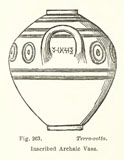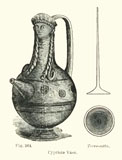Previous First Next
SALAMIS IN THE ISLAND OF CYPRUS.
BY ALEXANDER PALMA DI CESNOLÀ, F.S.A.,
page 114 
both in the act of walking, and carrying bundles of wood, or fascines, such as we call "faggots". Doubtless they may be about to attend a funeral pyre. These figures give extraordinary ' importance and value to the vase on which they appear. Among the thousands of vessels of this kind, no other that is known to me bears a representation of the human figure, or bird, or tree. All other enrichments of this category are geometrical, as for example, in the accompanying woodcut (fig. 263), which represents a double-handled vase, perhaps a stamnos,1 enriched with three double rings and a series of disks or double annulets round the widest part of the body, with a dot in the centre. On the space, between the insertions of the handle is the following Cypriote inscription:—

thus read by Professor Sayce:— ma . ta . ru . e . ο .--or in Greek equivalents:— ω epυ[e] θάμα. " Oh, carry often." The great variety of shapes exhibited by terra-cotta vessels, ornamented with spirals, bands, geometrical devices, animals,  and flowers, can be scarcely conceived without a personal view of them. There is hardly a shape known toarchaeologists that is not represented by them. Among them may be mentioned large jars with wide mouths, heart-shaped bodies, and two loop handles (see fig. 263), globular bodies with narrower necks, and only one handle (see fig. 264); hemispherical bodies, with a mouth having a diameter but little reduced from that of the body itself, and with one handle, the wine jar; true amphorae of the Rhodian style, as well as the allied forms, the cadus, orca, lagena, and seria; the hylix, the kantharns, the diota.2 The oinochoe, or wine-jug, which evidently ministered the dark sparkling wine at festive entertainments, of proportions sometimes truly heroic; the hydria, or water-pot; the halpis, shyphos, depas, pelïke, crater, and prochoos; tetinǽ,3 with tiny spouts. and flowers, can be scarcely conceived without a personal view of them. There is hardly a shape known toarchaeologists that is not represented by them. Among them may be mentioned large jars with wide mouths, heart-shaped bodies, and two loop handles (see fig. 263), globular bodies with narrower necks, and only one handle (see fig. 264); hemispherical bodies, with a mouth having a diameter but little reduced from that of the body itself, and with one handle, the wine jar; true amphorae of the Rhodian style, as well as the allied forms, the cadus, orca, lagena, and seria; the hylix, the kantharns, the diota.2 The oinochoe, or wine-jug, which evidently ministered the dark sparkling wine at festive entertainments, of proportions sometimes truly heroic; the hydria, or water-pot; the halpis, shyphos, depas, pelïke, crater, and prochoos; tetinǽ,3 with tiny spouts.
1 See Dennis, Cities ami Cemeteries of Etruria, New Edition, vol. i, p. cix.
2 See Birch, History of Ancient Pottery, new edition, p. 180.
3 Mr. H. Syer Cuming's Paper " On Early Tetinaa", in the Journal of the British Archǽological Association, gives illustrations of a large number of these objects.
The writer quotes Fosbrooke's Encyclopǽdia of Antiquities, s.v. Nursing, to show that " among the Greeks the nurses, during the time of sucking, used to carry the children out to air, having with them a sponge full of honey in a small pot, to stop crying". None can doubt, he continues, that in ancient, as in modern days, there were many instances in which hand- the widest part of the body, either to enable the holder to pour out a libation in a thin, trickling stream, or to allow a nurse to feed an infant by pouring a few drops of milk at a time into its mouth; wine-cups, with or without handles, long,  narrow, and truncated lecythi; and the nasiterna, or nozzle-mouthed jug, so-called from the length of its spout, many of which are ornamented or enriched with a series of small loops or eyes, either singly at intervals, or in pairs, regularly placed along each side of the body. These are generally glandular or ovoid in shape, with narrow spouts elongated on one side, and pinched together at the extreme end, in order that the liquid Firsts may be delivered in a very thin stream. Some of this last kind of vessel have threeor four short feet, to enable them to stand upright more securely.1. I may with propriety introduce here the figure (264) of a charming Cypriote vase of glazed red ware. There is a very similar vase to this in the Archaic Vase Room narrow, and truncated lecythi; and the nasiterna, or nozzle-mouthed jug, so-called from the length of its spout, many of which are ornamented or enriched with a series of small loops or eyes, either singly at intervals, or in pairs, regularly placed along each side of the body. These are generally glandular or ovoid in shape, with narrow spouts elongated on one side, and pinched together at the extreme end, in order that the liquid Firsts may be delivered in a very thin stream. Some of this last kind of vessel have threeor four short feet, to enable them to stand upright more securely.1. I may with propriety introduce here the figure (264) of a charming Cypriote vase of glazed red ware. There is a very similar vase to this in the Archaic Vase Room
Previous First Next
|